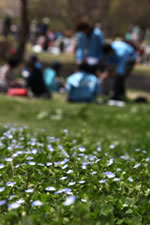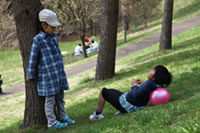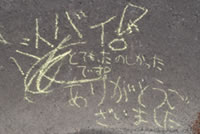



[TOKYO, Japan, 29 June 2011]
Since the disaster the psychological situation of children in the disaster area has been a major concern. The Japan Committee for UNICEF (JCU) has implemented a diverse range of assistance activities, including the establishment of Child Friendly Spaces, UNICEF Children’s Bus Fieldtrips and the UNICEF Children’s Mini Library project, in consideration of the psychological condition of children so that the shock and sadness created by the disaster would not grow into long lasting trauma. Recently, a group of play therapists (psychosocial experts that provide assistance through playing) that have been working with JCU to provide psychosocial assistance to children in the disaster areas reported on the situation of children from their expert perspective at an event they participated in during June. The following are excerpts from their reports.
* * * * *
 |
Even in safe and friendly environments, there were children that would overreact (repeatedly cry and call for their parents even though their parents were right there, appear to be startled, etc.) in response to minor stimuli (calls of staff members, other crying children, etc.). I could tell that the children were tense and nervous. I observed several children attempt to restore balance by engaging in such behavior as putting stickers on people they did not know or abruptly running out into the street. This mischievous behavior could be a manifestation of their confusion over how to conduct themselves in their new environment or their longing for someone to pay attention to them.
This is in regards to the drawing area. One boy took a whole bunch of chalk and drew a long line. He then drew a circle at each end of the line and then two dots inside of the circles. The boy then yelled, “It’s a snake! Run away!” He then ran away to another play area. Another boy drew a big square and called it a bus. He then drew a long line under the bus followed by a bus stop. He continued by extending the line under the bus a little and then drawing some trees. He extended the line a bit further and then drew a house. “I made a town,” he said. He then called his father over and said, “Dad, let’s live here.” This was his attempt at giving support to his father. One girl drew two small circles on the ground decorated with diamonds around them. “Anybody who steps in these circles will be happy,” she cheerfully exclaimed. A large number of children drew pictures, filling the event space with color. I was moved by the depth of expression children were capable through such diverse ways. It made me realize the importance of providing children with environments where they can feel comfortable expressing the many feelings they have. The children looked at ease as the numerous volunteers that took part in the event assisted them with their drawing.
 |
| This picture is not directly related to this article. |
When we were changing play stations I saw a girl sitting with her back to everyone, so I went and sat down next to her. She was crying and I told her, “It’s okay to cry.” She looked up at me and said quietly, “I’m lonely.” We just sat there together for a while and then, little by little, she began to turn and face the play area and smile at me. We eventually went to the animal feeding area together. At first she said, “I don’t want to pet the animals. It’s scary!” But before long she tried feeding the goats and rabbits. It appeared that she was sorting out her own feelings, taking from this experience that, “Even though it’s scary sometimes, it will be okay.” Staff from the Japan Committee for UNICEF also watched over these activities. The child gradually became less tense and able to smile again as she tried out different play stations and play with other staff. I saw that even children that were able to control themselves had lost their sense of security and required a lot of energy to begin playing.
 |
Once the staff announced that it was time to go home, most children said things like, “I want to play more,” “I can’t play if I go home,” “When can I come back next?” and “Can I come here again?” Moreover, a few of the children on their way to the bus abruptly turned back and said things like, “I forgot something” or “I just want to pet it one more time!” They then continued to run back to the petting zoo area, the furthest location away from the bus, clinging to the petting zoo staff. It was then that I strongly sensed that children wanted to play more, along with the harsh reality that each child faced and the scary feeling of having to return to that reality.
In total, the event made me sense the physical and mental need for a place for children to play in comfort. I also sensed the difficulty for the children’s parents, as they have to protect their families and continue life as normal while they face their own fears. I could see their need to see their children playing as children, and sometimes to get away to spend a little time alone.
* * * * *
The ability to express oneself and play has an important role in restoring the psychological balance of children in the disaster area. The Japan Committee for UNICEF will continue to work together with children in providing them assistance with the cooperation of a diverse range of experts.
All photo credits: © Japan Committee for UNICEF/2011/K. Goto
| Receiving Prefecture |
Type of Emergency Supplies |
Arrival Date |
Quantity | Donating Company |
Comments |
|---|---|---|---|---|---|
| Miyagi | Water | 19 Mar. | 12,288 bottles |
VanaH Co., Ltd. | Two-liter plastic bottles |
| Fukushima | Water | 22 Mar. | 12,672 bottles |
VanaH Co., Ltd. | Two-liter plastic bottles |
| Miyagi | Underwear for boys and girls | 22 Mar. | 200,000 | ||
| Iwate | Underwear for boys and girls | 23 Mar. | 30,000 | ||
| Fukushima | Water | 23 Mar. | 4,680 bottles |
KIRIN MC DANONE WATERS Co., Ltd. | Two-liter plastic bottles |
| Miyagi | Children’s shoes | 23 Mar. | 10,000 pairs |
||
| Miyagi | Children’s diapers | 24 Mar. | 80 packs | P&G Japan | |
| Iwate | Children’s underwear | 24 Mar. | 9,700 | ||
| Fukushima | Water | 24 Mar. | 12,288 bottles |
VanaH Co., Ltd. | Two-liter plastic bottles |
| Iwate | Shoes | 26 Mar. | 1,404 pairs | Achilles Corporation | |
| Iwate | Underwear for boys and girls | 27 Mar. | 28,266 | ||
| Iwate | Boots | 27 Mar. | 7,462 pairs | ||
| Iwate | Wipes | 28 Mar. | 1,200 | P&G Japan | For babies |
| Miyagi | Recreation kits Early Childhood Development kits |
2 Apr. | 50 of each | Procured from the UNICEF Supply Division | |
| Iwate | Recreation kits Early Childhood Development kits |
2 Apr. | 50 of each | Procured from the UNICEF Supply Division | |
| Miyagi | Book bags | 6 Apr. | 70 | Nihon New Bag Chain | |
| Iwate | Book bags | 6-7 Apr. | 340 | Seiban | |
| Miyagi | Schoolbags | 8 Apr. | 18,000 | Procured from the UNICEF Supply Division | |
| Iwate | Schoolbags | 8 Apr. | 18,000 | Procured from the UNICEF Supply Division | |
| Miyagi | Personal security buzzers (for crime prevention purposes) | 8 Apr. | 5,000 | ||
| Iwate | Personal security buzzers (for crime prevention purposes) | 8 Apr. | 5,000 | ||
| Miyagi | Minicar | 8 Apr. | 3 cars | ||
| Miyagi | Nutritional supplements | From early April | 4,000 bottles | ||
| Fukushima | Water | 11 Apr. | 1,536 bottles | VanaH Co., Ltd. | Two-liter plastic bottles |
| Miyagi | Replenishments for recreation kits | 12 Apr. | 60 sets | ||
| Miyagi | Miniature toy cars | 12 Apr. | Approx. 1,200 | TAKARA TOMY | |
| Sagamihara* | Water | 12 Apr. | 12,288 bottles | VanaH Co., Ltd. | Two-liter plastic bottles |
| Miyagi | Play mats | 13 Apr. | Two types; 80 of each type | IKEA | |
| Miyagi | Drawing sets | 13 Apr. | 60 sets | IKEA | |
| Iwate | Preschool-size chairs, tables and low tables | 14 Apr. | 75 chairs; 11 tables; 9 low tables | Donated to preschools, primary schools, junior high schools and high schools in the disaster area as well as their new locations | |
| Miyagi | Mopeds | 15 Apr. | 5 | ||
| Iwate | Notebooks and stationery sets for primary and junior high school students | 15. Apr. | 16,700 sets | ||
| Miyagi | 183 computers; 57 copiers and fax machines; 61 printers | 18-21 Apr. | Distributed to preschools, primary schools, junior high schools and high schools in the disaster area as well as their new locations | ||
| Fukushima | Movable blackboards | 21 Apr. | 10 | ||
| Fukushima | Temporary toilets | 22 Apr. | 20 | ||
| Iwate | Geiger counters | 28 Apr. | 14 | For schools in Soma City | |
| Iwate | Dressing room/ breastfeeding partition system | 28 Apr. | 21 sets | ||
| Saitama* | Milk | From late April | Shelter in Futabamachi, Kazo City | ||
| Saitama* | Yogurt | From early May | Danone Japan | Shelter in Futabamachi, Kazo City | |
| Iwate | Color pencils (120 sets) and paint (240 sets) | 13 May | |||
| Iwate | Student lamps | 14 May | 15 | ||
| Iwate | Stationery sets | 16 May | 840 sets | ||
| Fukushima | Lockers | 16 May | 22 sets | For the Board of Education of Minamisoma City | |
| Fukushima | Computers | 16 May | 1 | Ishikawa Town Board of Education | |
| Miyagi | 2 copiers; 2 computers; 2 printers | May | For Higashi-Matsushima Day-Care Center and Watari Day-Care Center | ||
| Iwate | Water receiving tank, water purifier tank, water supply tank | May construction | May construction | ||
| Miyagi | Solar-powered vaccine refrigerator | 18 May | |||
| Fukushima | Fans | 30 May | 112 | Minamisoma City Board of Education | |
| Fukushima | Masks | 30 May | 100,000 | Minamisoma City Board of Education | |
| Iwate | 1 copy machine | 2 June | |||
| Saitama* | Shoes | 15 June | 460 pairs | Converse Footwear Co., Ltd. |
-Number of UNICEF Children’s Mini Libraries distributed: Approximately 150,000 books to over 900 locations (as of 20 June 2011).
-Number of children that have participated in the UNICEF “Let’s Play! The Outdoors Playtime Project” in Fukushima Prefecture: Approximately 5,600 (as of 26 May)
*Areas receiving disaster victims.
*In certain cases some supplies may be taken from prefectural supply storage warehouses and distributed to shelters and disaster sites in other prefectures.
As of 9:00 a.m. on 17 June 2011 (compiled by the Information and Public Affairs Division).